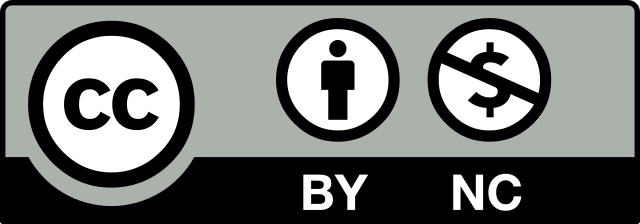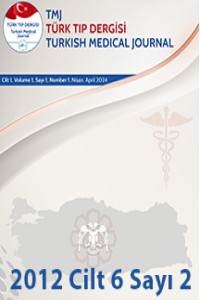BLOOD LACTATE LEVELS IN INTOXICATIONS AND THE USAGE OF LACTATE CLEARANCES TO DETERMINE THE EFFECTIVENESS OF TREATMENT
Öz
Aim: The aim of this study is to measure the lactate levels at the beginning and at the 6th and 24th hours of drug poisonings with the clearance rate of lactate and to determine the availability of the use of these parameters for the assessment of drug poisoning treatment.
Materials and Methods: Patients over 16 years, who were treated in the Emergency Department, Critical Care Unit of Konya Training and Research Hospital for drug intoxications between November 2011 and February 2012 and who agreed to participate in the study were selected. Patients were divided into five groups, according to their drugs takes such as paracetamol, organophosphates, selective serotonin receptor inhibitors (SSRIs), non steroid anti-inflammatory drugs (NSAIDs) and others. Lactate clearances were calculated by determining the lactate levels at the admission (lactate 1) and on the 6th (lactate, 2) and 24th hours.
Results: 80 patients were included in the study. 68.8% of the patients were female, 31.3% were male. The most commonly used drugs used in intoxications were; NSAIDs and paracetamol, respectively. The mean lactate level was 1.34mmol/l. The rate of lactate clearance was 19% on the 6th hour and 29% on the 24th hour. In the paracetamol group, there was a significant decrease on the 6th hour, compared to other drug groups (p <0.01) and in the paracetamol group, the clearance of lactate was significantly increased on the 24th hour, as well (p <0.05).
Conclusion: Especially for paracetamol intoxication, the rate of lactate clearance can be increased and blood lactate levels can be reduced by appropriate and adequate fluid therapy
Anahtar Kelimeler
Kaynakça
- 1. T.C Sağlık Bakanlığı. Birinci Basamağa Yönelik Zehirlenmeler Tanı ve Tedavi Rehberi; SB, RSHMB, Hıfzıssıhha Mektebi Müdürlüğü, Yayın No:712, Ankara: Yücel Ofset Matbaacılık; Ekim 2007.
- 2. Nguyen HB, Rivers EP, Knoblich BP, et al. Early lactate clearance is associated with improved outcome in severe sepsis and septic shock Crit Care Med 2004; 32:1637-4.
- 3. Protti A, Fortunato F, Monti M, Vecchio S, Gatti S, Comi GP, De Giuseppe R, Gattinoni L. Metformin overdose, but not lactic acidosis per se, inhibits oxygen consumption in pigs. Crit Care. 2012;16:R75 (http://ccforum.com/con-tent/16/3/R75).
- 4. Head JM. Ethylene glycol ingestion masked by concomitant ethanol intoxication. BMJ Case Reports 2012; doi:10.1136/bcr.12.2011.5326.
- 5. Levy B. Lactate and shock state: the metabolic view. Curr Opin Crit Care 2006; 12:315-21.
- 6. Sargın G, Yavaşoğlu İ, Kadıkoylu G, Bolaman Z. Laktik Asidoz: Olgular üzerinden kısa bir gozden gecirme. Yoğun Bakım Derg 2011; 3: 63-6.
- 7. Cinel I. Sepsiste patogenez. Türkiye klinikleri. J Surg Med Sci 2006; 2:8-20.
- 8. Esen F. Sepsis patofizyolojisine yeni bakış. Türkiye Klinikleri. J Surg Med Sci 2006; 2:21-23.
- 9. Wang H, Yang H, Tracey KJ. Extracellular role of HMGB1 in inflammation and sepsis. J Intern Med 2004; 255:320-31.
- 10. Benaissa ML, Mégarbane B, Borron SW, Baud FJ. Is elevated plasma lactate a useful marker in the evaluation of pure carbon monoxide poisoning? Intensive Care Med. 2003;29:1372-5.
- 11. Sokal JA, Kralkowska E. The relationship between exposure duration, carboxyhemoglobin, blood glucose, pyruvate and lactate and the severity of intoxication in 39 cases of acute carbon monoxide poisoning in man. Arch Toxicol. 1985;57:196-9.
- 12. Sheen CL, Dillon JF, Bateman DN, Simpson KJ, Macdonald TM. Paracetamol toxicity: epidemiology, prevention and costs to the health-care system. QJM 2002; 95: 609–19.
- 13. Roth B,Woo O, Blanc P. Early metabolic acidosis and coma after acetaminophen ingestion. Ann Emerg Med 1999; 33: 452–6.
- 14. Mendoza CD, Heard K, Dart RC. Coma,metabolic acidosis and normal liver function in a child with a large serum acetaminophen level. Ann Emerg Med 2006; 48: 637.
- 15. Bernal W, Donaldson N, Wyncoll D,Wendon J. Blood lactate as an early predictor of outcome in paracetamol-induced acute liver failure: a cohort study. Lancet 2002; 359:558–63.
- 16. Macquillan GC, Seyam MS, Nightingale P, Neuberger JM, Murphy N. Blood lactate but not serum phosphate levels can predict patient outcome in fulminant hepatic failure. Liver Transpl 2005;11:1073–9.
- 17. Anoop D Shah, David M Wood, Paul I Dargan. Understanding lactic acidosis in paracetamol (acetaminophen) poisoning. Br J Clin Pharmacol. 2011; 71: 20–28.
İNTOKSİKASYONLARDA SERUM LAKTAT DÜZEYLERİ VE TEDAVİNİN ETKİNLİĞİNİN BELİRLENMESİNDE LAKTAT KLİRENSLERİNİN KULLANILMASI
Öz
Amaç: Bu çalışmanın amacı, ilaç zehirlenmelerinde, başvuru anındaki laktat düzeylerinin ölçülmesi ve 6 ve 24. Saatlerde alınan laktat düzeylerine göre hesaplanan laktat klirens hızına bakılarak, tedaviyi değerlendirilmektir.
Materyal ve Metod: Konya Eğitim ve Araştırma Hastanesi Acil Servis’e Kasım 2011- Şubat 2012 tarihleri arası ilaç zehirlenmesi nedeniyle başvuran ve toksikoloji yoğun bakımda çalışmaya katılmayı kabul eden erişkin hastalar (yaş>16) çalışmaya dâhil edildi. Hastalar aldıklara ilaçlara göre Parasetamol, organofosfatlar, selektif serotonin reseptör inhibitörleri (SSRI), non streroid anti inflamatuar ilaçlar (NSAİİ) ve diğer olmak üzere 5 gruba ayrıldı. Kan gazındaki geliş laktatı (laktat 1) 6. saatteki laktat (laktat 2) ve 24. Saatteki laktat (laktat 3) sonuçlarından laktat kliresi hesaplandı.
Bulgular: Çalışmaya 80 hasta dâhil edilmiştir. Hastaların %68,8’i kadın, %31,3’ü erkektir. Aldıkları ilaçlara bakıldığında en sık alınan ilaçlar NSAİİ, ikinci sıklıkla Parasetamol’dür. Hastaların başvuru anında geliş ortalama laktatı 1,34 mmol’dü. 6. Saatteki laktat klirens hızı %19, 24. Saatteki laktat klirensi ise %29’du. Tüm ilaç gruplarında laktat düzeyine bakıldığında, Parasetamol grubunda diğer ilaç gruplarına göre 6. saat laktat düzeyi anlamlı olarak daha fazla azalma göstermiştir (p<0,01). Yine Parasetamol grubunda, diğer ilaç gruplarına göre 24. Saatte bakılan laktat klirensi de anlamlı olarak daha fazla artış göstermiştir (p<0,05).
Sonuç: Uygun ve yeterli sıvı tedavisi ile özellikle parasetamol intoksikasyonlarında laktat klirens hızı artırılarak, kan laktat düzeyi azaltılabilir.
Dr. Emine AKINCI
Dr. Ekrem Taha SERT
Dr. Ramazan KÖYLÜ
Anahtar Kelimeler
Kaynakça
- 1. T.C Sağlık Bakanlığı. Birinci Basamağa Yönelik Zehirlenmeler Tanı ve Tedavi Rehberi; SB, RSHMB, Hıfzıssıhha Mektebi Müdürlüğü, Yayın No:712, Ankara: Yücel Ofset Matbaacılık; Ekim 2007.
- 2. Nguyen HB, Rivers EP, Knoblich BP, et al. Early lactate clearance is associated with improved outcome in severe sepsis and septic shock Crit Care Med 2004; 32:1637-4.
- 3. Protti A, Fortunato F, Monti M, Vecchio S, Gatti S, Comi GP, De Giuseppe R, Gattinoni L. Metformin overdose, but not lactic acidosis per se, inhibits oxygen consumption in pigs. Crit Care. 2012;16:R75 (http://ccforum.com/con-tent/16/3/R75).
- 4. Head JM. Ethylene glycol ingestion masked by concomitant ethanol intoxication. BMJ Case Reports 2012; doi:10.1136/bcr.12.2011.5326.
- 5. Levy B. Lactate and shock state: the metabolic view. Curr Opin Crit Care 2006; 12:315-21.
- 6. Sargın G, Yavaşoğlu İ, Kadıkoylu G, Bolaman Z. Laktik Asidoz: Olgular üzerinden kısa bir gozden gecirme. Yoğun Bakım Derg 2011; 3: 63-6.
- 7. Cinel I. Sepsiste patogenez. Türkiye klinikleri. J Surg Med Sci 2006; 2:8-20.
- 8. Esen F. Sepsis patofizyolojisine yeni bakış. Türkiye Klinikleri. J Surg Med Sci 2006; 2:21-23.
- 9. Wang H, Yang H, Tracey KJ. Extracellular role of HMGB1 in inflammation and sepsis. J Intern Med 2004; 255:320-31.
- 10. Benaissa ML, Mégarbane B, Borron SW, Baud FJ. Is elevated plasma lactate a useful marker in the evaluation of pure carbon monoxide poisoning? Intensive Care Med. 2003;29:1372-5.
- 11. Sokal JA, Kralkowska E. The relationship between exposure duration, carboxyhemoglobin, blood glucose, pyruvate and lactate and the severity of intoxication in 39 cases of acute carbon monoxide poisoning in man. Arch Toxicol. 1985;57:196-9.
- 12. Sheen CL, Dillon JF, Bateman DN, Simpson KJ, Macdonald TM. Paracetamol toxicity: epidemiology, prevention and costs to the health-care system. QJM 2002; 95: 609–19.
- 13. Roth B,Woo O, Blanc P. Early metabolic acidosis and coma after acetaminophen ingestion. Ann Emerg Med 1999; 33: 452–6.
- 14. Mendoza CD, Heard K, Dart RC. Coma,metabolic acidosis and normal liver function in a child with a large serum acetaminophen level. Ann Emerg Med 2006; 48: 637.
- 15. Bernal W, Donaldson N, Wyncoll D,Wendon J. Blood lactate as an early predictor of outcome in paracetamol-induced acute liver failure: a cohort study. Lancet 2002; 359:558–63.
- 16. Macquillan GC, Seyam MS, Nightingale P, Neuberger JM, Murphy N. Blood lactate but not serum phosphate levels can predict patient outcome in fulminant hepatic failure. Liver Transpl 2005;11:1073–9.
- 17. Anoop D Shah, David M Wood, Paul I Dargan. Understanding lactic acidosis in paracetamol (acetaminophen) poisoning. Br J Clin Pharmacol. 2011; 71: 20–28.
Ayrıntılar
| Birincil Dil | Türkçe |
|---|---|
| Konular | Acil Tıp |
| Bölüm | Araştırma Makalesi |
| Yazarlar | |
| Yayımlanma Tarihi | 21 Ağustos 2012 |
| Yayımlandığı Sayı | Yıl 2012 Cilt: 6 Sayı: 2 |



